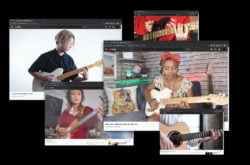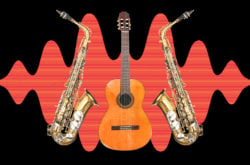Illustration: Louis Byrne
The barriers to entry for recording your electric guitar have never been lower.
Until not too along ago, capturing a quality sound for your guitar meant investing in a great amp, microphones, acoustic treatment, and any number of pedals depending on the effects you wanted to achieve. And it’s not to say that these items are obsolete today—they absolutely do still have their benefits, and above all can be incredibly fun to use and amass. However, for those of us with a limited space and budget, technology has granted us something truly incredible: amp simulator plugins. In this article, we explore what guitar amp simulator plugins are, how they sound, their pros and cons, and some of the best options out there today.
Let’s dive in!
What are guitar amp simulator plugins?
As their name implies, guitar amp simulator plugins allow us to emulate the sound of a physical amp, entirely in-the-box. Most DAWs come with a stock option these days, and there are also a myriad of third-party options that you can explore (we’ll highlight a few later). Depending on the plugin, some also allow you to emulate effects pedals and even microphone placement.

Logic Pro’s built-in amp simulator
How to use amp simulator plugins
The process of connecting your guitar to an amp simulator is very straightforward. First, plug your guitar into your audio interface (if you don’t have one, here are some solid budget options). From there, load up a new audio track in your DAW, and make sure the correct input channel is selected if your interface has multiple inputs. Then, simply add your amp simulator plugin to the channel strip as you would with any other audio effect, and you’re good to go! You’ll be able to adjust your tone by clicking into the plugin itself, and by turning input monitoring on, you’ll be able to jam and hear any changes live.
How they sound
A listen is worth a thousand words—let’s take a listen to how amp simulators sound. To establish a baseline, below is an unamplified guitar recording, simply captured via our interface with no additional effects applied.
Our guitar sound, only processed by the pre-amp in our interface
Now, let’s try applying a few contrasting tones using presets from an array of different plugins.
The “Present Day” preset from Logic Pro’s built-in Amp Designer
The “Crunch” preset from Waves’ CLA Guitars
The “Insane 5153” preset from Positive Grid’s BIAS AMP 2
Not bad, right? While amp simulators have been around for years, it’s amazing to hear how far some of the built-in and low-cost options in particular have come in terms of quality.
Some popular options
If you’re looking to go beyond what’s available in your DAW, there are countless high-quality options out there that you can explore. Below, we highlight just a few across different price points that you might want to consider checking out.
1. Waves’ CLA Guitars (~$29 – $99)
Made in partnership with celebrated mixing engineer Chris Lord-Alge, Waves’ CLA Guitars is one of those plugins that’s simple and sweet. Hundreds of presets are replaced with just three core tones (“Clean,” “Crunchy,” and “Heavy”), which can actually be immensely helpful in maintaining creative flow if they’re your cup of tea. Above all, the plugin is typically just $29.99 (its full price is technically $99.99, but Waves runs very frequent sales campaigns), which can make it a great first upgrade from stock alternatives for those who are on a tight budget.
2. Neural DSP’s Archetype series (~$115 – $150)
Though relatively new to the scene, Neural DSP’s Archetype plugins are easily among the most highly-regarded amp simulators on the market. Made in collaboration with today’s trailblazing guitarists (including the likes of Cory Wong, Polyphia’s Tim Henson, and Animals as Leaders’ Tosin Abasi), their sounds are both unique yet highly applicable to all sorts of genres. Veteran producer Kenny Beats calls the Archetype amps a “game-changer” as he walks through some of his own tones in his Skills lessons, and frankly we couldn’t agree more.
3. Positive Grid’s BIAS AMP 2 and BIAS FX 2 (~$299)
One of those unique manufacturers that makes both physical and virtual amps, Positive Grid leans into versatility and customizability as some of their top selling points. You can really get into the nuts-and-bolts of designing your own amp with BIAS AMP 2, but if you’re not looking to get that granular (and/or prefer messing around with pedalboards), then BIAS FX 2 is a great alternative too. Both also share a nifty feature called ToneCloud, which lets you browse and download presets crafted by an array of guitarists. While they’re more expensive compared to some other options, Positive Grid also tends to offer quite significant discounts during the holidays.
The pros and cons of amp simulator plugins
While amp simulator plugins are pretty great, they won’t be replacing their hardware counterparts outright any time soon. Starting with the obvious, physical amps will continue to be integral to any rehearsal and live settings that go beyond the studio. And even within recording sessions, the physicality of twisting knobs and hearing the warm vibrations of an amp in a room can generate different timbres as well as musical ideas. Lastly, while this can usually be remedied with a touch of smart processing, some amp simulators tend to lean a little ‘bright’ or ‘thin,’ which can give them that digital sound that many guitarists find less desirable.
That said, their numerous pros simply can’t be denied. For a fraction of the price, modern simulator plugins can achieve sounds that are truly competitive with physical amps and pedals. The DI nature also bypasses a room’s acoustics, which allows bedroom musicians to obtain a level of quality that would otherwise be inaccessible (while simultaneously preserving positive relationships with roommates and neighbors with a pair of headphones). Lastly, because processing is being applied entirely in-the-box, you can always go back and A/B or reimagine tones, without having to painstakingly re-record parts.
Do you have any guitar amp simulator plugins that you recommend? Let us know in the comments below.
Dive deeper with Kenny Beats’ perspective on top guitar amp plugins, engineering, production, and more:
October 29, 2021



